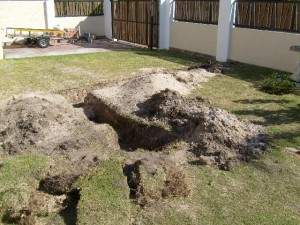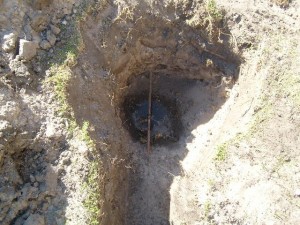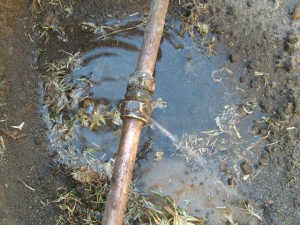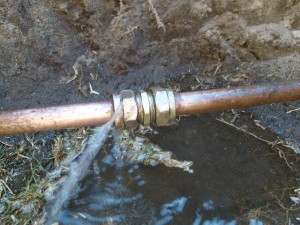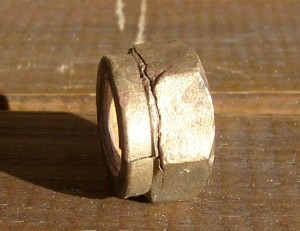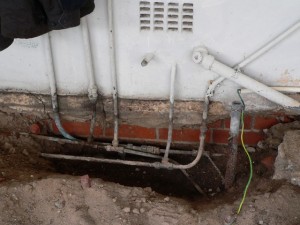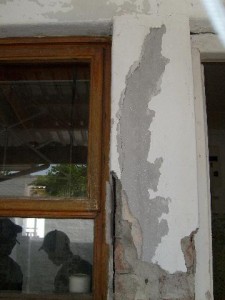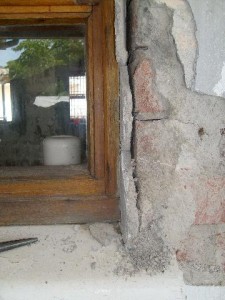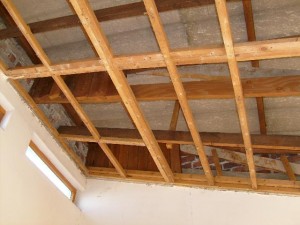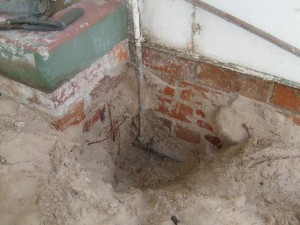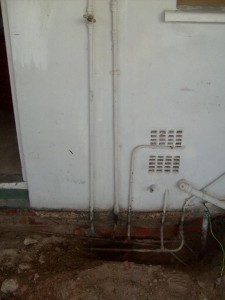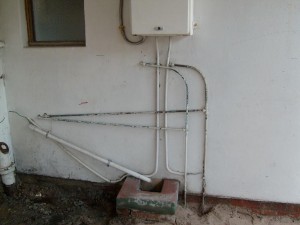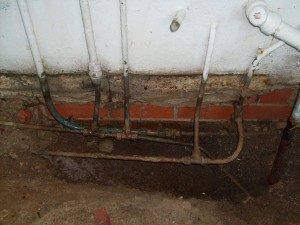horrors
Doing our bit to save the environment, part 2
Our water bill has been high every month since we got the house. I attributed it to the building and other work going on, but now that we’re settled in, it became clear that Something Is Not Right.
Specifically, we’re using about 40 thousand litres a month. That’s about 10 thousand US gallons.
So I thought I should make a daily note of the water meter reading, to see what’s happening (Many councils have a habit of estimating usage based on one month’s consumption, for months on end). Immediately noticed that the wheel is turning, even though I knew there was no water running anywhere in the house.
Closing the stop cocks available to me, I figure it must be a leak in the plumbing I didn’t replace. The water mains enters the property through a stop cock, from there (I think) it goes to two outside taps, and then to the junction which feeds the geyser (via a stopcock), the prep bowl and the toilets.
This is the junction, below all the other stuff I ripped out (picture from April 2008, when I just started). It feeds the geyser (thick pipe going left and bending up) and the toilets and prep bowl (the other side of the T junction). All the other cold water taps are fed from the geyser side of the pressure regulator, so that the hot & cold water pressures are the same, so that mixer taps work right. And taking the geyser offline doesn’t stop the meter.
So, the leak is either under the front lawn, at the junction, or under the house. I’m guessing the latter. Tomorrow it’s Frank and a spade, that’s the only way to find out.
Dreaded Previous Owner
I came across the term “DPO” when I joined the Land Rover Owners mailing list — this is the guy you bought the vehicle from, who sealed an oil leak with bubblegum or put banana peels in the gearbox to hide the whine or rewired the entire vehicle using only one colour wire — you get the idea.
Turns out that houses have DPOs too. This crumbling plasterwork by the [1] kitchen window courtesy of not removing all of the iron framed window when replacing it with a nice new wooden one. The iron rusted, pushed the plaster out, and plastering over it just didn’t work (go figure).
Our “fix” might lead to the next owner of the house future-blog-equivalent-ing about it in much the same way. (We removed as much of the rust as we could, then stuffed the cavity with white shipping foam, then plastered over it, the idea being that future rust expansion would compress the foam and not lift the plaster).
[1] My brother objects to my use of “<over there> by the <something>”. Doesn’t stop me from (ab)using the term.
Because why, I can.
Progress
I borrowed a few builders’ props from my father, and we very carefully cut a lintel into the outside of the double wall, propped that up and cemented it in, and then cut a lintel into the other side of the wall… all the time keeping the props in place to prevent the unsupported “corner” where the four lintels come together from collapsing.
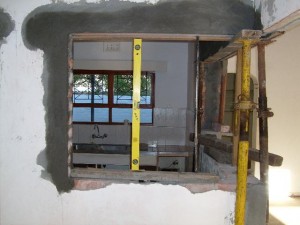
So I come home to this. The props have moved, and are now being used to mostly support the planks used for plastering. I ask Frank about it, “Oh no, this house is very strong”. !
It’s a good thing the house has indeed turned out to be very strong, because the team is young and immortally reckless sometimes…
(Also note the creative use of the spirit level as a temporary support)
This framework supported the ceiling boards. It’s difficult to see, but the trusses are formed by a beam carrying the roof crossmembers, and another beam below it, with lots of crossbracing.
At the top, both beams are cemented into the wall. At the bottom however, the lower beam hangs from the upper beam, and is not attached to the wall at all.
So I don’t know whether the lower beam is there to carry weight (it can’t) or to hang the ceiling from (in which case, why the cementing at the top and the crossbracing?).
Anyway, the framework had to go. Next thing I saw was two guys on top of the framework, hitting it with hammers to get it off the beams above. Yes, they were lying on the framework while hammering at it. Four meters off the ground.
I also used to be young and immortal but *shudder*. I mean, I was too horrified to even take pictures.
This is (used to be) the hot water pipe on its way up to the shower. I wonder how much energy was wasted heating up the stoep from below.
The pipes! The pipes!
The horror! The horror!
Whoever did the piping had… interesting ideas. I found the main feed, 3/4″, going to the geyser in the roof. Coming from the geyser there’s another 3/4″ pipe, which disappears under the cement stoep and from there presumably some magic happens, resulting in hot and cold water pipes sprouting from the stoep where required.
Of course this means that the water will take a while to get hot. And I don’t know what the heat loss in or under the cement stoep is — suffice to say that This Must Go.
OK, I need to take bits of the stoep up to plumb in the new bathroom, and other bits of the stoep are cracked, so chopping it all up to get at the pipes is no biggie. En ek skrik nie vir plumbing nie, net vir die prys van koper.
A friend pointed me at a new product on the market — some plastic composite type water pipe that’s compatible with compression fittings (there are also plastic compression fittings available but I’m not sure I trust them). It’s a lot cheaper than copper and flows a lot better than polycop, it might just work.
So I’m off to buy a rather large geyser [1] from De La Rey (which is called Builder’s Warehouse these days but who cares). I’ll see about plumbing a solar collector into this [2].
And then the pipes will run straight and to the point and I’ll even wrap some insulation around them.
Oh Danny Boy..
[1] The geyser that’s in there at the moment sports a five-digit Cape Town phone number (we’re up to 7 these days) which sort of hints at the age of the house. And it’s rusting from the outside in. But mostly it’s one of those horribly inefficient tank types, and now’s a good time to replace it.
[2] Buying a solar, electrically assisted geyser would be easier, good for the environment (or maybe just for Eskom), and roughly ten times as expensive if you include everything. I can’t afford to pay for Eishkom’s mistakes, I’m afraid.
